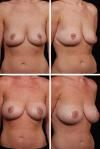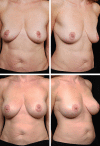Postreduction Breast Augmentation
- PMID: 26579333
- PMCID: PMC4634164
- DOI: 10.1097/GOX.0000000000000479
Postreduction Breast Augmentation
Abstract
Most breast reduction patients are highly satisfied after surgery. However, there is a subset of women who seek breast augmentation years later to restore lost volume chiefly associated with weight loss and postpartum changes. Breast shape and overall aesthetics are often revised at the same time.
Methods: A retrospective review was performed of 2 surgeons' experiences with post-reduction breast augmentation. Twenty patients were identified between 2002 and 2014. An in-depth chart review was conducted to determine patient motivation and to examine the operative techniques employed. Implant variables, a reduction specimen weight to implant volume comparison (where available), and complications are reported.
Results: The average age was 37.1 years and average body mass index was 21.8 kg/m(2). Most patients waited over a decade to have their breasts revised. Weight loss was the motivating factor in 8 patients and pregnancy changes in 11. Nineteen patients wished to stay with the same bra size or 1 cup size larger. Although all patients elected to have an implant placed, 19 patients wished to have an improved breast shape, not specifically a larger volume. The average breast implant was 203.5 cm(3) (range, 120-340 cm(3)). Complications from implant placement included a seroma treated by aspiration and a Baker class III capsular contracture that required surgical correction.
Conclusions: A small subset of reduction mammaplasty patients seek breast augmentation many years later primarily to improve breast contour, not to restore their prereduction breast volumes. Conservative augmentation combined with revision of breast shape and areolar aesthetics yields good results with minimal complications.
Conflict of interest statement
Figures


Similar articles
-
Aesthetic and technical refinements in latissimus dorsi implant breast reconstruction: a 15-year experience.Aesthet Surg J. 2011 Feb;31(2):190-9. doi: 10.1177/1090820X10395506. Aesthet Surg J. 2011. PMID: 21317117
-
Why do patients seek revisionary breast surgery?Aesthet Surg J. 2013 Feb;33(2):237-44. doi: 10.1177/1090820X12472693. Aesthet Surg J. 2013. PMID: 23388645
-
The correction of capsular contracture by conversion to "dual-plane" positioning: technique and outcomes.Plast Reconstr Surg. 2003 Aug;112(2):456-66. doi: 10.1097/01.PRS.0000070987.15303.1A. Plast Reconstr Surg. 2003. PMID: 12900603
-
Surgeons' Dilemma: Treatment of Implant-Associated Infection in the Cosmetic Breast Augmentation Patient.Aesthetic Plast Surg. 2019 Aug;43(4):905-909. doi: 10.1007/s00266-019-01369-7. Epub 2019 Apr 3. Aesthetic Plast Surg. 2019. PMID: 30944965 Review.
-
A review of the literature on the etiology of capsular contracture and a pilot study to determine the outcome of capsular contracture interventions.Aesthetic Plast Surg. 1999 May-Jun;23(3):197-206. doi: 10.1007/s002669900268. Aesthetic Plast Surg. 1999. PMID: 10384019 Review.
Cited by
-
Shaping the Silhouette: A Comprehensive Review of Surgical Body Contouring Techniques for the Torso and Limbs.Cureus. 2025 Jul 25;17(7):e88737. doi: 10.7759/cureus.88737. eCollection 2025 Jul. Cureus. 2025. PMID: 40861576 Free PMC article. Review.
References
-
- Foreman KB, Dibble LE, Droge J, et al. The impact of breast reduction surgery on low-back compressive forces and function in individuals with macromastia. Plast Reconstr Surg. 2009;124:1393–1399. - PubMed
-
- Mello AA, Domingos NA, Miyazaki MC. Improvement in quality of life and self-esteem after breast reduction surgery. Aesthetic Plast Surg. 2010;34:59–64. - PubMed
-
- Davis GM, Ringler SL, Short K, et al. Reduction mammaplasty: long-term efficacy, morbidity, and patient satisfaction. Plast Reconstr Surg. 1995;96:1106–1110. - PubMed
-
- Koltz PF, Myers RP, Shaw RB, et al. Adolescent breast reduction: indications, techniques, and outcomes. Plast Reconstr Surg. 2011;127:158e–159e. - PubMed
-
- Aboudib JH, Castro CC, Coelho RS, et al. Analysis of late results in postpregnancy mammaplasty. Ann Plast Surg. 1991;26:111–116. - PubMed
LinkOut - more resources
Full Text Sources
